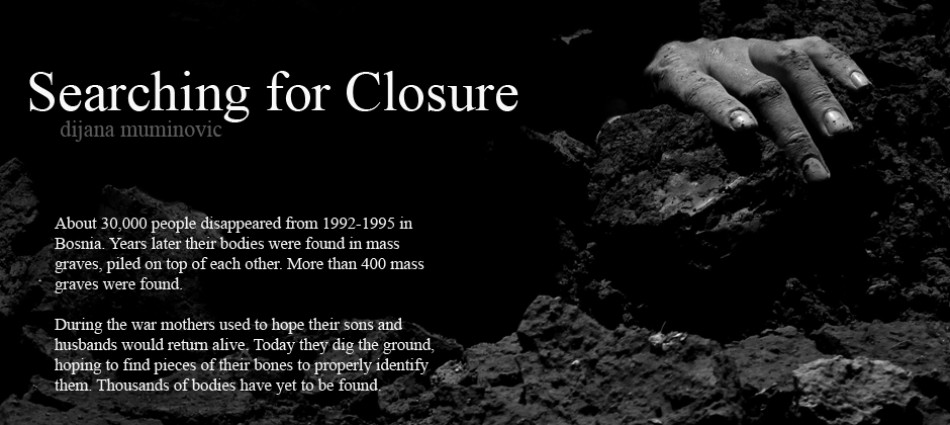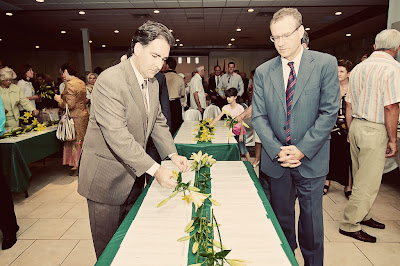FILM - The Geography of Genocide in Bosnia: Redeeming the Earth
Date & Time: Tue. Nov. 30, 2010 4:00 pm - 6:00 pm
A Film Screening sponsored by the International Relations Graduate Program. The Geography of Genocide in Bosnia: Redeeming the Earth, A film by Jonah Quickmire Pettigrew and David Pettigrew.
Tuesday, November 30, 2010; 4 – 6 pm; UMASS Boston, Healey Library, 11 th Floor Room 11B
Please join us for the screening of this documentary which will be followed by a discussion with Producer Dr. David Pettigrew, Professor of Philosophy, Southern Connecticut State University.
For disability related accommodations please complete the form at www.ada.umb.edu or contact UMass Boston Customer Service Center at 617 2874000, email [email protected]
For information about this event, contact the Department of Conflict Resolution, Human Security and Global Governance at UMass Boston, 6172877489
http://www.lib.umb.edu/node/3972
Photojournalist Dijana Muminovic, documenting the crime of genocide
About 30,000 people disappeared from 1992-1995 in Bosnia. Years later their bodies were found in mass graves, piled on top of each other. More than 400 mass graves were found. During the war mothers used to hope their sons and husbands would return alive. Today they dig the ground, hoping to find pieces of their bones to properly identify them. Thousands of bodies have yet to be found.
- Dijana Muminovic, Searching for Closure
In 1992, Serb forces killed thousands of Bosniak civilians around Srebrenica, particularly in communes of Višegrad and Bratunac. They dumped their corpses into the Drina River. Then in July of 1995, Serb forces committed genocide in Srebrenica. Truckloads of unarmed Bosniak men and boys as young as 12 were slaughtered and dumped into the Drina River.
Their bodies ended up in Perućac, an artificial lake partly in the municipalities of Srebrenica and Višegrad in Bosnia and Herzegovina and partly in the municipality of Bajina Bašta, Serbia.
In July and August 2010, when the level of the reservoir waters behind the Bajina Bašta hydroelectric dam was lowered while maintenance and repair work was being done on the dam, the remains of approximately 250 civilians who perished in the Višegrad massacres in 1992 and the Srebrenica genocide in 1995, were discovered.
Photojournalist Dijana Muminović visited Perućac to documented a terrible crime hidden beneath the lake for a long time. Please visit her web site:
European Parliament’s Srebrenica Genocide Resolution
European Parliament’s Srebrenica Genocide Resolution
Report on Višegrad by Prof. David Pettigrew
Witnessing Exhumations on the Drina: Fifteen Years After Dayton:
Note: photographs that accompany the report can be found here.
In July 2009, the Lukić cousins, Milan and Sredoje, were convicted by the International Criminal Tribunal for the former Yugoslavia of war crimes committed in Višegrad, a town in Eastern Bosnia, between 7 June 2021 and 10 October 1994. Milan Lukić was a leader, and Sredoje Lukić a member, of the “White Eagles,” a special military unit under the authority of the Bosnian Serb Army. The White Eagles terrorized many other towns in eastern Bosnia as well, including Zvornik. As part of the general pattern of “ethnic cleansing” that characterized the founding of Republika Srpska, the Bosnian Serb Army forcibly displaced some 10,000 Bosnian Muslims (Bosniaks) from the Višegrad municipality and destroyed local mosques. The mosque in the center of Višegrad, for example, was leveled, and it has not been rebuilt. In addition, Serb forces murdered nearly 3,000 Bosniaks in the Višegrad area. The murders were both systematic and random. Under the local “Crisis Committee” that coordinated civil and military units, many community and religious leaders were identified and targeted. Other residents were caught in periodic round-ups. The Lukić cousins themselves were convicted of two separate incidents of forcing 120 civilians into two houses and setting the houses on fire, killing nearly all of the occupants: women, children and elderly. Many other civilians were viciously murdered on the town’s Ottoman bridge and on the riverbank. Their bodies were thrown into the Drina river. It is estimated that nearly 1,000 of the victims are still missing.
Upon the reading of his guilty verdict in 2009, Milan Lukić-who had been apprehended in Buenos Aires in 2005- shook his head, expressing his disdain and denying his crimes. His denial is indicative of widespread denial in Višegrad and in Republika Srpska today. This past July 12, the day after the commemoration of the 15th anniversary of the genocide at Srebrenica, the Prime Minister of Republika Srpska, Milorad Dodik, denied that the genocide at Srebrenica had occurred.
However, recent work on a nearby dam caused the level of the Drina river to drop dramatically. In defiance of the denials of Lukić and Dodik, the bones of the victims were suddenly visible on the riverbanks and in the riverbed.
The Bosnia Missing Persons Institute (MPI) was able to begin combing the riverbanks and marking the bones. Here a bone protruded from the mud, there a collection of bones was visible on the surface: a finger, a radius bone and a vertebrae. Yellow flags marked the bones and orange flags marked unexploded grenades and shells.
During one of their first forays on July 27, the Institute’s team was fired upon by an unidentified gunman. Approximately a week later, on August 4th, the Institute organized a convoy to return to the site with forensic investigators from the International Commission for Missing Persons, as well as public service workers from Sarajevo (parks and mortuary employees) equipped with tools to assist in the task of scraping away layers of the riverbed.
The Missing Persons Institute’s director, Amor Mašović, along with his staff and the specialists from the International Commission for Missing Persons (ICMP) — young professionals from the US, England and Canada- spent hours working on the riverbed, exposed to potential snipers, unexploded ordnance and poisonous snakes. Each ICMP forensic investigator was assigned five public employees. Under the careful guidance of the ICMP specialist, the workers began digging at the mud on the surface. As the bones beneath became more visible, the forensic specialist would move in and do the delicate work of clearing the mud and freeing the skeleton from the riverbed. In one location alone, near Mušići village, a tangle of four or five full skeletons was soon to be revealed.
The identification of the bones will help bring some closure to the surviving relatives of the victims. Further, these discoveries will offer additional proof of the war crimes that were committed in Višegrad, crimes for which only a few of the perpetrators, including the Lukićs, and Mitar Vasiljević, have been convicted. The value of this work, then, cannot be underestimated as part of a continuing effort to uncover the truth of the genocidal crimes in the face of official denials.
In the town of Višegrad today, there is small park in honor of Ivo Andrić, -author of the Nobel prize-winning novel Bridge on the Drina—located at the entrance to the Ottoman bridge that was constructed from 1571 to 1577. Directly across the street, a poster is clearly visible on a storefront. The poster bears a color photograph of the indicted war criminal Vojislav Šešelj, founder of the Serbian Radical Party. His head is framed by the insignia of the White Eagles, a symbol of Serbian nationalism and also of the military unit responsible for many of the acts of depraved violence against the Bosniak civilians in Višegrad. The poster bears the phrase “Free Šešelj! [Слобода Шешељу-Sloboda Šešelju.] For Bosniaks who would seek to return to their homes and neighborhoods in Višegrad, as part of the social reintegration promised by the Dayton Peace Accords, this poster is a form of cruel psychological violence.
The bones in the Drina, however, and those who are laboring to uncover the truth that rests in the riverbed, say that these crimes will not be denied and these victims will not be forgotten.
Post script: by August 18, 2010, it was reported that 73 skeletons had been found.
Note: photographs that accompany the report can be found here.
* * * * * * * * * * * * * * * * * * * * * * * * * * * *
This report is a result of two visits to Višegrad, July 31 and August 4, 2010, as well as research and personal interviews. My thanks to Amor Mašović, Director of the Bosnia Missing Persons Institute, for inviting me to accompany the convoy August 4th, 2010. Thanks to my friends Aldin Hadžić, Hikmet Karčić, Velma Šarić, Omer Sulejmanović, and Jack Hitt, for all their help in the preparation of this brief report. Special thanks to Rialda Ocuz at BHRT.
Hellish Suffering of Bosniaks in Besieged Srebrenica (1993)
Author: Daniel Toljaga
Part I/III - Starvation in Pre-Genocide Srebrenica: There was a constant and serious shortage of food in pre-genocide Srebrenica causing starvation to peak in the winter of 1992/1993. Many Bosniak refugees, particularly women and children, were in an extremely emaciated state due to malnutrition and many of them died from starvation.
A very rare footage you are about to see shows just how desperate the humanitarian situation was in Srebrenica in March 1993, more than two years before the Srebrenica genocide. What follows is the first of three extracts of news programmes broadcast by ABC News with footage shot by Tony Birtley, a British reporter, showing the scenes of starvation in Srebrenica in March 1993. I’ve obtained the clip from the “ICTY Court Records” database of the International Criminal Tribunal for the Former Yugoslavia (ICTY). Please watch it ↓ Read more
The 1993 Srebrenica Children Massacre
The Srebrenica Children Massacre occurred more than two years before the Srebrenica genocide. On April 12th 1993, Serbs from heavily armed villages around Srebrenica deliberately targeted Srebrenica’s elementary school killing 74 Bosniak children and seriously injuring more than 150 children. One of them was Sead Bekric. Please take a look at the following testimony from the United States Holocaust Memorial Museum (USHMM) in Washington, D.C.
Serbian Attempts to Conceal Evidence of Srebrenica Genocide (Documentary)
WATCH DOCUMENTARY (29 minutes)
Everyone remembers the harrowing footage of the Srebrenica massacre shot by Zoran Petrovic, the only cameraman to capture the events on film. But this week’s fascinating documentary shows that the very worst of his pictures never reached our TV screens. Key scenes from Petrovic’s rushes were ‘lost’ or blacked over, presumably to prevent reprisals. We unearth the lost images, and the completed jigsaw is even more heinous than the already blood-spattered picture. Amazingly, Petrovic has never been interviewed by the War Crimes Tribunal about what he saw. For the first time, his incriminating material is available for scrutiny. Read more
Bosnia: A Short History, by Noel Malcolm
Toronto, Canada - 15th Commemoration of Srebrenica Genocide
An update from Toronto (Canada), including the text and beautiful photographs, kindly provided by Dina Bajric of FacePhotography.ca. Thank you Dina, we’re proud of you. (More photos are available at this link!)
Two Honorable Canadian MPs, Mr. Brian Masse and Mr. Rob Oliphant, commemorate the 15th anniversary of the Srebrenica Genocide in Toronto, Canada.
Canadians Remembering Srebrenica Genocide - Promoting education, remembrance and research of the Srebrenica genocide
July 11th 2010 marked the 15th anniversary of the Srebrenica Genocide. In commemoration of this tragedy Toronto’s Bosnian community hosted a series of well organized and well received events: a photo exhibit at the Gladstone Hotel, a silent march in downtown Toronto, and a commemoration ceremony in Etobicoke. Events were organized in partnership with the Congress of North American Bosniaks and the Institute for the Research of Genocide-Canada.



